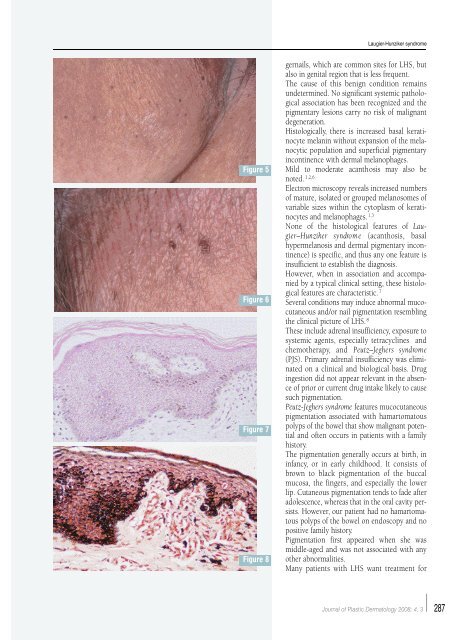N° 3 - Salute per tutti
N° 3 - Salute per tutti
N° 3 - Salute per tutti
Create successful ePaper yourself
Turn your PDF publications into a flip-book with our unique Google optimized e-Paper software.
Figure 5<br />
Figure 6<br />
Figure 7<br />
Figure 8<br />
Laugier-Hunziker syndrome<br />
gernails, which are common sites for LHS, but<br />
also in genital region that is less frequent.<br />
The cause of this benign condition remains<br />
undetermined. No significant systemic pathological<br />
association has been recognized and the<br />
pigmentary lesions carry no risk of malignant<br />
degeneration.<br />
Histologically, there is increased basal keratinocyte<br />
melanin without expansion of the melanocytic<br />
population and su<strong>per</strong>ficial pigmentary<br />
incontinence with dermal melanophages.<br />
Mild to moderate acanthosis may also be<br />
noted. 1,2,6<br />
Electron microscopy reveals increased numbers<br />
of mature, isolated or grouped melanosomes of<br />
variable sizes within the cytoplasm of keratinocytes<br />
and melanophages. 1,3<br />
None of the histological features of L a u -<br />
gier–Hunziker syndro m e (acanthosis, basal<br />
hy<strong>per</strong>melanosis and dermal pigmentary incontinence)<br />
is specific, and thus any one feature is<br />
insufficient to establish the diagnosis.<br />
However, when in association and accompanied<br />
by a typical clinical setting, these histological<br />
features are characteristic. 7<br />
Several conditions may induce abnormal mucocutaneous<br />
and/or nail pigmentation resembling<br />
the clinical picture of LHS. 8<br />
These include adrenal insufficiency, exposure to<br />
systemic agents, especially tetracyclines and<br />
c h e m o t h e r a p y, and Peutz–Jeghers syndro m e<br />
(PJS). Primary adrenal insufficiency was eliminated<br />
on a clinical and biological basis. Drug<br />
ingestion did not appear relevant in the absence<br />
of prior or current drug intake likely to cause<br />
such pigmentation.<br />
Peutz-Jeghers syndrome features mucocutaneous<br />
pigmentation associated with hamartomatous<br />
polyps of the bowel that show malignant potential<br />
and often occurs in patients with a family<br />
history.<br />
The pigmentation generally occurs at birth, in<br />
infancy, or in early childhood. It consists of<br />
brown to black pigmentation of the buccal<br />
mucosa, the fingers, and especially the lower<br />
lip. Cutaneous pigmentation tends to fade after<br />
adolescence, whereas that in the oral cavity <strong>per</strong>sists.<br />
However, our patient had no hamartomatous<br />
polyps of the bowel on endoscopy and no<br />
positive family history.<br />
Pigmentation first appeared when she was<br />
middle-aged and was not associated with any<br />
other abnormalities.<br />
Many patients with LHS want treatment for<br />
Journal of Plastic Dermatology 2008; 4, 3<br />
287

















